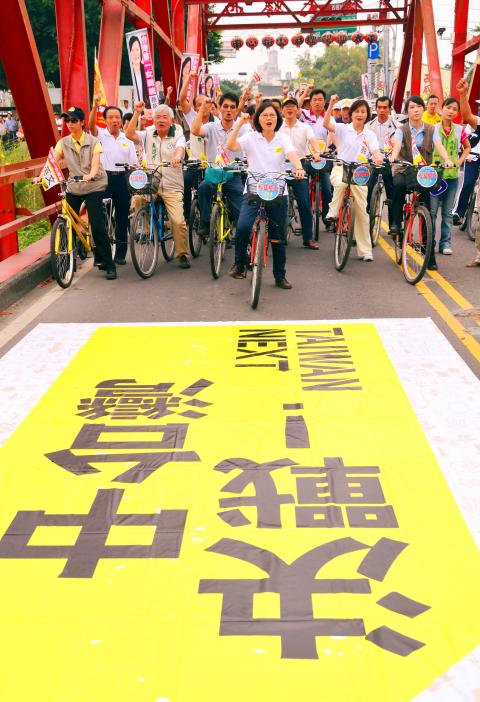Democratic Progressive Party (DPP) Chairperson Tsai Ing-wen (蔡英文) yesterday called on supporters to make their voices heard in the north as she crossed the Jhuoshuei River (濁水溪), the symbolic dividing line between north and south Taiwan.
Yunlin County Commissioner Su Chih-fen (蘇治芬) said crossing the Jhuoshuei symbolized that the DPP’s influence was continuing to spread northwards.
Tsai’s campaign tour moved along the No. 1 Provincial Highway yesterday, bringing her to Citong (莿桐) and Siluo (西螺) townships on the banks of the Jhuoshuei, where she visited temples and roadside rest areas and sampled local dishes.

Photo: CNA
Tsai then biked to Changhua County, accompanied by party members and supporters, chanting the slogan: “Crossing the Jhuoshuei River, fighting out the election in central Taiwan.”
The DPP’s Central Standing Committee held its weekly meeting in Changhua County yesterday, the seventh day of the campaign tour.
Tsai, the party’s presidential candidate, gave a briefing on her tour and said that all staff in campaign headquarters nationwide were pumped up with enthusiam and were even starting to make bets with each other on how many more votes the party would win in January’s presidential election compared with the 2004 election.
The general morale is great, Tsai said.
After watching a short clip of the rally along the No. 1 Provincial Highway over the past week, Tsai said she truly felt the passion of her supporters since the first leg of the rally in Pingtung.
She was very moved by the amount of support and told those who said it was essential for her to win the election that they were the ones she depended on to make that come true, Tsai said.
Over the past seven days, Tsai has attended an average of 15 events daily, closely tailed by the media.
Political figures are often defeated by the media, but politicians can also trump the media, Tsai said, adding that she believed if she kept up her efforts, “one day we can defeat whom we want to defeat.”
The rally held on Sept. 24 in Greater Taichung drew a crowd of supporters similar in size to that at the No. 1 Provincial Highway in the past few days, Tsai said in an interview, adding that she expected the passion of DPP supporters would expand over the Jhuoshuei.
“I hope that in the event along the entire No. 1 Provincial Highway, people will come and participate no matter if it is north or south of the Jhuoshuei River,” Tsai said.
“I expect that more and more people will join us the farther north we go,” she said.
“Party members in Pingtung told me that support would grow gradually chillier the farther north I went,” Tsai said, adding that she had a great rally in Greater Kaohsiung, which was perhaps even more passionate than in Pingtung.
“I expect the grand finale to be in Greater Tainan,” Tsai said, adding that she did not expect to have another climactic rally in Chiayi.
Translated by Jake Chung, staff writer

Taiwan is to commence mass production of the Tien Kung (天弓, “Sky Bow”) III, IV and V missiles by the second quarter of this year if the legislature approves the government’s NT$1.25 trillion (US$39.78 billion) special defense budget, an official said yesterday. Commenting on condition of anonymity, a defense official with knowledge of the matter said that the advanced systems are expected to provide crucial capabilities against ballistic and cruise missiles for the proposed “T-Dome,” an advanced, multi-layered air defense network. The Tien Kung III is an air defense missile with a maximum interception altitude of 35km. The Tien Kung IV and V

The disruption of 941 flights in and out of Taiwan due to China’s large-scale military exercises was no accident, but rather the result of a “quasi-blockade” used to simulate creating the air and sea routes needed for an amphibious landing, a military expert said. The disruptions occurred on Tuesday and lasted about 10 hours as China conducted live-fire drills in the Taiwan Strait. The Civil Aviation Administration (CAA) said the exercises affected 857 international flights and 84 domestic flights, affecting more than 100,000 travelers. Su Tzu-yun (蘇紫雲), a research fellow at the government-sponsored Institute for National Defense and Security Research, said the air

Taiwan lacks effective and cost-efficient armaments to intercept rockets, making the planned “T-Dome” interception system necessary, two experts said on Tuesday. The concerns were raised after China’s military fired two waves of rockets during live-fire drills around Taiwan on Tuesday, part of two-day exercises code-named “Justice Mission 2025.” The first wave involved 17 rockets launched at 9am from Pingtan in China’s Fujian Province, according to Lieutenant General Hsieh Jih-sheng (謝日升) of the Office of the Deputy Chief of the General Staff for Intelligence at the Ministry of National Defense. Those rockets landed 70 nautical miles (129.6km) northeast of Keelung without flying over Taiwan,

A strong continental cold air mass is to bring pollutants to Taiwan from tomorrow, the Ministry of Environment said today, as it issued an “orange” air quality alert for most of the country. All of Taiwan except for Hualien and Taitung counties is to be under an “orange” air quality alert tomorrow, indicating air quality that is unhealthy for sensitive groups. In China, areas from Shandong to Shanghai have been enveloped in haze since Saturday, the ministry said in a news release. Yesterday, hourly concentrations of PM2.5 in these areas ranged from 65 to 160 micrograms per cubic meter (mg/m³), and pollutants were